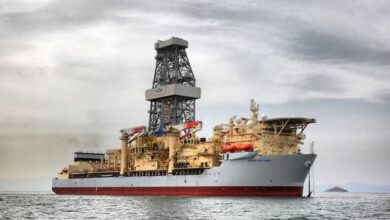State of offshore rig market is all about rig supply – yet nobody knows how many offshore rigs there are in the market anymore
Offshore rig supply has become nearly impossible to pin down, but the market may be doing better than what consensus indicates
By David Carter Shinn, Bassoe Offshore

What’s the state of the offshore rig market today? In four words, it’s not that bad.
Sure, rig demand hasn’t risen as much as it was forecasted to do. When rigs do get drilling contracts, they don’t make much money. There are a lot of stacked rigs sitting around. There’s still a need for more contractor consolidation.
But where’s the market going? There’s a lot to look at under the surface. If you look closely, especially at rig supply, the market seems much better than the consensus might say.
Rig demand forecasts are getting stale
Forget about the oil price. Forget about shale. Forget about all the reports you’ve read that say offshore rig demand will rise by this year or that year.
Most demand forecasts have been proven wrong already because they forecasted an earlier rise in rig demand, which hasn’t materialized. The rig market was supposed to be great in 2017, 2018, 2019, right?
That said, we do see rising demand for jackups in the Middle East, Southeast Asia and West Africa. The midwater harsh-environment semisubmersibles market looks so good that distressed newbuilds have found new owners – and Awilco placed the market’s first newbuild rig order in four years. The deepwater market, led by Petrobras and IOCs, is starting to experience regrowth in Brazil and increased drilling interest in countries like Guyana and Argentina.
But forget about rig demand for now. It will reconcile itself at some point.
The real part of the equation to focus on is rig supply
Oversupply has, of course, been a main theme since 2014, when oil companies suddenly cut their CAPEX budgets and everyone realized that too many offshore rigs had been built.
But it’s not just the fact that rig oversupply has reached one of its highest levels in history that makes it such an important issue to consider. The real reason supply has become interesting is that demand has been so languid and difficult to prognosticate.
As demand continues to be difficult to predict, supply forecasts now dominate investor presentations and analyst reports. If you can reasonably derive a low number for the number of competitive rigs in the market, then you don’t have to rely on demand as much to make your case for happier days.
Offshore rig supply has never been so difficult to figure out

Normally, supply is relatively easy to forecast – at least for two or three years out – compared with demand. The approximate amount of time required to build a rig is known, so fleet additions aren’t difficult to visualize. And in normal markets, you can assume some sort of steady rate of attrition.
The problem now is that supply is at least as uncertain as demand. Rigs have been sitting around for longer than they’ve ever done before, while owners hope that they will somehow get another opportunity to squeeze a little more life out of their assets.
Nearly 200 rigs have already left the fleet, either for recycling or conversion, since 2014, but with approximately 125 rigs delivered during that time – and approximately an additional 100 units still waiting to be delivered – attrition hasn’t helped the fleet as much as it could have.
That still leaves a lot of rigs out there that probably won’t drill again. We call these “zombie rigs.” They usually meet at least one of the following criteria: old (built before 2000); haven’t worked in over a year; and passed their special survey due date.
Figuring out just how many non-competitive rigs are out there is nearly impossible. Rig owners either don’t want you to know – or don’t even know themselves – exactly how many rigs are still viable assets.
And even though we don’t think you should worry about zombie rigs, they still muddle the current and future utilization picture.
At the same time, the other part of the supply side is murky. There probably will be newbuilds that never make it to delivery. During the rig-building boom, inexperienced shipyards wanted to get in on the action – especially in the jackup market. Now, most of these rigs are controlled by the yards, over budget and undesirable to established rig owners. They’re in the back of a long line of rigs from more experienced yards waiting to enter the market.
And although newbuild uncertainty is less of a problem in the floater segment, delivery timelines are still getting pushed out and are largely unconfirmed.
As supply is likely to have the most influence (versus demand) on the future of the rig market for the next few years, it’s vital that we try to understand it.
Nobody knows how many rigs are in the market anymore
If we look at the numbers, we see just how wild the supply side is.
Let’s first take out all rigs we identify as non-competitive, or rigs which are old, haven’t worked in over a year or are past their special survey due dates. That takes approximately 110 rigs out of the fleet.
Then let’s split up each rig segment into groups: new rigs; newbuilds; old rigs that are drilling; newbuilds likely to never be delivered; and old rigs with no future contracts (but perhaps not yet non-competitive).
You then get a range for jackup supply of between 340 and 518 rigs. Most demand forecasts don’t have potential deviations that are so wide.
Semisubmersibles also have a large potential supply range. Between 87 to 130 semis are, or could be, competitive today.
Drillships seem to have much more supply visibility because the vast majority of them are new, and the old ones have been scrapped. The problem here, which we’ll address later on, is that there are just too many of them, no matter how you slice up the fleet, and supply will have to fall.
Even with the uncertainty of supply, the market looks good

What’s interesting is that, even with a blurry supply picture, scenarios that give 85% utilization are still very feasible.
If the market returns to somewhere near its high demand of 397 jackups, then to get to 85% utilization, we’ll need 467 rigs in the fleet compared with today’s high supply number of 518. To balance the market, 51 jackups – in addition to more than 70 that are already considered “out” – need to disappear.
We feel comfortable taking out the 38 stacked old rigs with no future contracts and the 15 newbuilds that will never be delivered. With just those, we’re down to under 467 rigs. And there’s still a pool of 125 old rigs that are currently drilling and could be retired when their current contracts terminate and special survey and upgrade costs become too high to justify keeping them in service. Some of these will end up leaving the fleet, too.
For jackups, we can estimate that the fleet will shrink by 90 rigs over the next two years. As such, demand doesn’t even need to reach its previous highs for the market to reach a healthy utilization level.
For semisubmersibles, the picture is much the same. Demand once surpassed 160 rigs. You can put a much more conservative number on semi demand – say, 107 rigs, which implies a required supply of 126 rigs. Today’s high supply number is 130, so four rigs need to leave the fleet. With a pool of 11 old stacked rigs with no contract and 32 old rigs that are still on contract, the likelihood that real supply will fall to an acceptable level is also high.
Drillships, as noted earlier, don’t have a pool of old rigs that can be relied on to reduce supply. If we put an optimistic demand number of 86 (the all-time high), we get to a required supply of 101 rigs versus a current maximum real supply of 121 rigs. After removing the few remaining non-competitive units, we’re left with only four, which can reasonably be assumed to become non-competitive in the short term (one stacked and three still on contract). At least 16 new drillships must then leave the fleet.
Considering the condition of some of the more modern cold-stacked drillships and the likelihood of prolonged suppressed demand, it wouldn’t be unrealistic to assume that enough ultra-deepwater rigs will exit the market. That said, that supply/demand balance in the drillship market is still years away.
If you believe in a demand growth story, then supply isn’t a problem either
You can look at the numbers all day. You can play with demand and supply. But if you believe that demand will resolve itself, then you can find a clear path toward achieving an appropriate level of supply. As dayrates stay low, we see the supply picture continuing to develop in the right direction. With low rates, old rigs (with higher capital expenditure costs) have less of a chance to compete, and they become more likely to leave.
How the supply side plays out will be much more interesting than what happens on the demand side. And supply discovery will bring us into a rig market with high utilization, higher dayrates and better cash flows for owners of modern, well-maintained assets. DC




